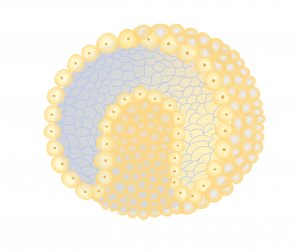15.3 Gastrulation, neurulation, and beyond
Gastrulation, the formation of a gastrula, occurs around 3 weeks post-fertilization (week 5 of pregnancy). At this stage, the embryonic cells are characterized by three distinct layers: the ecotoderm, the mesoderm, and the endoderm. The cells are said to have differentiated and will give rise to one of several specific tissue types.


Neurulation, the formulation of neurula, occurs around week 4 post-fertilization (week 6 of pregnancy). At this stage the neural tube (which becomes the spinal cord and brain) closes and the tissues that will eventually comprise the brain begin to fold inward. The embryo at this stage is about 3 mm in length (or about half the length of a grain of rice).
After neurulation, the limb buds begin to form and the embryo elongates. At 7 weeks post-fertilization (week 9 of pregnancy) the embryo is about 15 mm in length and has limbs and digital rays that will eventually become fingers and toes.
At around the 12th week after fertilization (week 14 of pregnancy) the embryo becomes classified as a fetus and the pregnancy enters the second trimester. The fetus is about 10 cm long at this point. Somewhere around the 24th week of pregnancy, the fetus, if delivered early, may be viable with medical intervention; current survival rates for babies born at 24 weeks, and that receive extensive medical care, are around 50%. The third trimester begins around the 27th week. Pregnancy continues until roughly 40 weeks after the date of last menstruation. For detailed explanation of the stages of embryonic and fetal development, see https://embryology.med.unsw.edu.au/embryology/index.php/Main_Page
Pluripotency
Cells that can differentiate into any cell type are pluripotent. They are often also called stem cells. Stem cells are of interest to scientists for basic research and for their potential for use in the treatment of certain human diseases such as blood cancers and neurodegenerative diseases. Embryonic stem cells are derived from the inner cells of a blastula. There are adult stem cells in places like bone marrow that are not completely pluripotent, but these cells can also differentiate into a more limited number of cell types. The use of human embryonic stem cells in research has been controversial because it involves the destruction of a human embryo at the blastula stage. The source for these embryonic stem cells has generally been extra embryos that were created by in-vitro fertilization (IVF; see description in the fertility treatments table in chapter 14).
As researchers have learned more about pluripotency, they have learned to induce adult non-stem cells into pluripotency. These types of cells may someday replace embryonic stem cells in research and therapeutic applications.
Check Yourself

